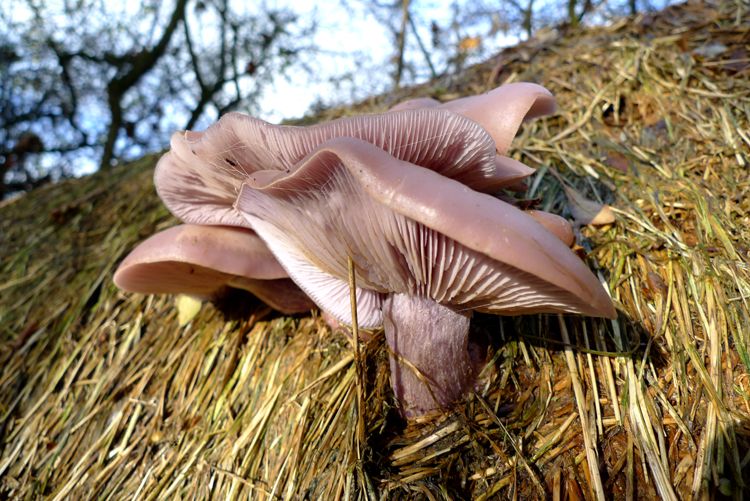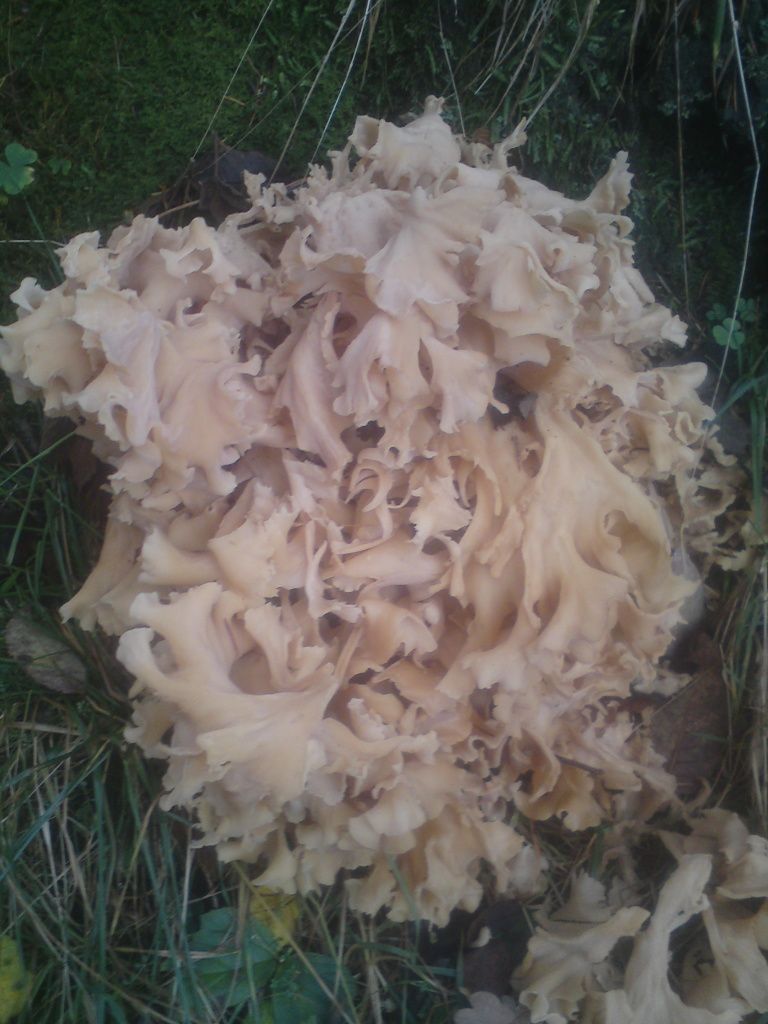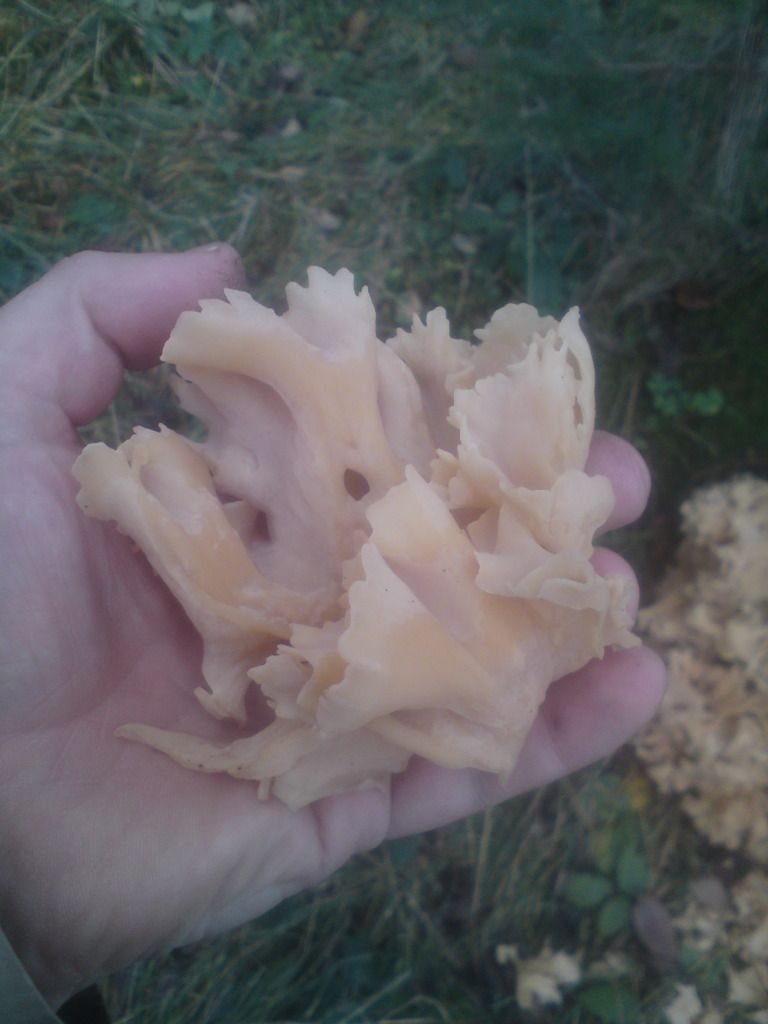Any ideas? Growing on a large hay bale that farmers have helpfully dumped in the middle of the lane.



Any ideas? Growing on a large hay bale that farmers have helpfully dumped in the middle of the lane.

Lepista nuda - wood blewit for me... interesting substrate!
If in doubt it should smell perfumed, and have a pale pink spore print.
Iona
Hi there,
demographic, I'd love it if you could post a picture of the full fruiting body of your Sparassis, I think you may have been right the first time...
S. crispa is more likely to have the toothed margin, thinner lobes, and I've had it looking very much like yours, illustrated on the right of my photo below. I've linked a photo of Sparasis spathulata as well to illustrate the thicker flatter margined lobes, which are usually zoned, and in the new 2012 Buczacki Collins it's listed as growing on Broad leaf trees (Usually sweet chestnut, beech and oak) in italic, and it states that 'host species is the surest means of identifying these fungi'...


Cheers,
Iona
Michael Jordan's Encyclopedia said:S. spathulata:
associated with wood, parasitic on soil at the base of broad-leaf and coniferous trees
Could be Clitocybe (was Lepista) sordida. I've found that growing on hay before.
Could be (still) Lepista sordida, but the colour and stature suggest nuda...
You were very adamant on this particular one, without the whole thing to look at, and it looks nothing like it to me... just an open S. crispa... and the book I was quoting was much newer and takes into account more recent info. And, looking at the photos I've posted again, and the first photo demographic posted, which would you say looked closer?
Iona
I think I'm getting bored of this game quite quickly.
Hi there,
demographic, I'd love it if you could post a picture of the full fruiting body of your Sparassis, I think you may have been right the first time...
S. crispa is more likely to have the toothed margin, thinner lobes, and I've had it looking very much like yours, illustrated on the right of my photo below. I've linked a photo of Sparasis spathulata as well to illustrate the thicker flatter margined lobes, which are usually zoned, and in the new 2012 Buczacki Collins it's listed as growing on Broad leaf trees (Usually sweet chestnut, beech and oak) in italic, and it states that 'host species is the surest means of identifying these fungi'...


Cheers,
Iona


These are the only photos I took of it I'm afraid.
It was definitely growing at the foot of a coniferous tree but to be honest I'm not that good on my coniferous tree IDs, I'm far and away better on my deciduous tree IDs
Hi there,
demographic, I'd love it if you could post a picture of the full fruiting body of your Sparassis, I think you may have been right the first time...
S. crispa is more likely to have the toothed margin, thinner lobes, and I've had it looking very much like yours, illustrated on the right of my photo below. I've linked a photo of Sparasis spathulata as well to illustrate the thicker flatter margined lobes, which are usually zoned, and in the new 2012 Buczacki Collins it's listed as growing on Broad leaf trees (Usually sweet chestnut, beech and oak) in italic, and it states that 'host species is the surest means of identifying these fungi'...


Cheers,
Iona
Andreas Gminder said:I'm not sure wether you speak about the same species that in continental Europe is known as Sparassis laminosa (or S. brevipes or S. nemecii)? If so, I can confirm that what we call S. laminosa is grwoing definitely with Abies [FIR] as main host, besides that with Picea [SPRUCE]. Then there are very rare collections of a laminosa-like species with Fagus and Quercus, but it is not sure whether this is the same Sas . laminosa on Abies or if it is better called S. brevipes (or S. nemecii?).
Right. Sparassis spathulata is the latest name (synonym) for S. laminosa (according to Michael Jordan's book.)
The new book you quote says spathulata grows on chestnut (Castanea), beech (Fagus) and oak (Quercus.)
However, according to Andreas Gminder (I am guessing you know who Andreas is), last night:
In other words, the experts are not in agreement, but Andreas Gminder appears to be going further than Michael Jordan (who says they grow on both) and saying that the "laminosa-like species" (the ones with longer, flatter blades) grow mainly on conifers, rather than deciduous trees, and that the species growing on deciduous trees may be a different sub-species. In fact from the more general discussion I got the impression that the genus Sparassis is going to be re-arranged or split into more (sub-)species than are currently recognised.
I think this is what it means, anyway.
